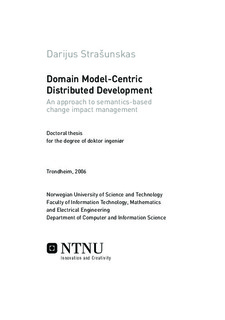| dc.contributor.advisor | Sølvberg, Arne | nb_NO |
| dc.contributor.author | Strasunskas, Darijus | nb_NO |
| dc.date.accessioned | 2014-12-19T13:29:46Z | |
| dc.date.available | 2014-12-19T13:29:46Z | |
| dc.date.created | 2006-02-09 | nb_NO |
| dc.date.issued | 2006 | nb_NO |
| dc.identifier | 125819 | nb_NO |
| dc.identifier.isbn | 82-471-7762-5 | nb_NO |
| dc.identifier.uri | http://hdl.handle.net/11250/249818 | |
| dc.description.abstract | Today’s information systems engineering involves large number of stakeholders, wide geographical distribution and wide range of tools. Success in system engi-neering depends on effective human communication. Early understanding and modelling of the problem domain is a key to manage large scale systems and pro-jects. This requires stakeholders to reach a certain level of shared interpretation of the domain referred throughout the development
We propose a method for semantics driven change impact assessment. In our method, first a collaborative problem analysis is conducted. The problem analysis results in an agreed and committed common understanding of the prob-lem domain, expressed in a conceptual domain model. The constructed concep-tual domain-specific model is then actively used as a communication medium, e.g., to abstract development objects from representation format in order to expli-cate their semantics. Stakeholders browse the domain model and interactively as-sociate to product fragments by selecting concept clusters that best describe the contents (intended meaning) of the product fragments.
Associations of the development objects with concepts from domain model, as well as the domain model itself constitute the basis for change impact assess-ment throughout the development. Every revision of a development object in-vokes change impact notifications that are either confirmed or rejected. Accumu-lated statistics are used to refine associations via the domain model to the direct dependency links among development objects.
The method has been implemented in a prototype system CO2SY and has been evaluated in an experiment, where a set of test users has been provided with a problem domain description including a domain model and a set of develop-ment objects. The experiment was based on two real world cases. Users were asked to perform tasks using the prototype and two comparative tools. The method and prototype have been evaluated with respect to actual performance and users perceptions. The result shows actual effectiveness, perceived ease of use and usefulness comparing to other tools used in the experiment, as well as intention of the subjects to use the method in future.
A discussion of future research directions and possible revisions of the method concludes the thesis. | nb_NO |
| dc.language | eng | nb_NO |
| dc.publisher | Fakultet for informasjonsteknologi, matematikk og elektroteknikk | nb_NO |
| dc.relation.ispartofseries | Doctoral Theses at NTNU, 1503-8181; 2006:12 | nb_NO |
| dc.subject | Information systems engineering | en_GB |
| dc.subject | geographically distributed development | en_GB |
| dc.subject | conceptual domain model | en_GB |
| dc.subject | change impact | en_GB |
| dc.subject | traceability | en_GB |
| dc.subject | SOCIAL SCIENCES: Statistics, computer and systems science: Informatics, computer and systems science: Information technology | en_GB |
| dc.title | Domain Model-Centric Distributed Development: An approach to semantics-based change impact management | nb_NO |
| dc.type | Doctoral thesis | nb_NO |
| dc.source.pagenumber | 311 | nb_NO |
| dc.contributor.department | Norges teknisk-naturvitenskapelige universitet, Fakultet for informasjonsteknologi, matematikk og elektroteknikk | nb_NO |
| dc.description.degree | dr.ing. | nb_NO |
| dc.description.degree | dr.ing. | en_GB |
